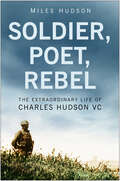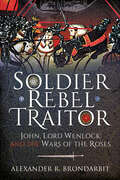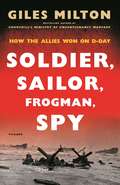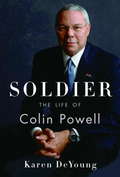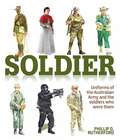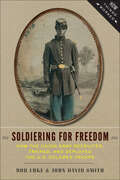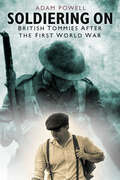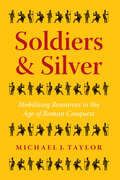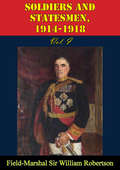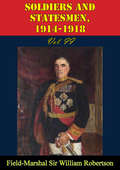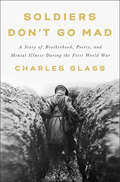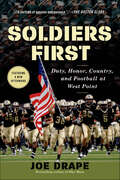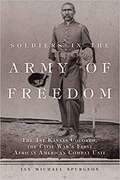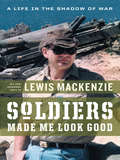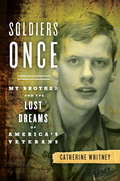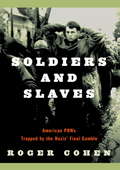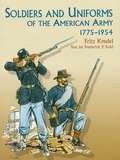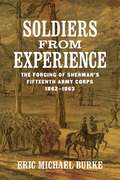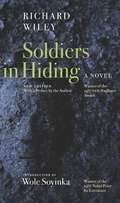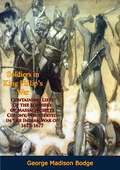- Table View
- List View
Soldier, Poet, Rebel: The Extraordinary Life of Charles Hudson VC
by Miles HudsonCharles Hudson VC was one of the twentieth century's outstanding fighting soldiers. His military career through two world wars and in Russia in 1919 earned him a host of medals. He was also a man of deep feeling, an accomplished poet and, in many ways, a rebel. In this compelling biography, the author skilfully interweaves his own narrative insight with his father's wartime journals and other unpublished material. The narrative includes detailed personal descriptions of the Battle of the Somme and other actions. It recounts the authoress Vera Brittain's bitter reaction to the death of her brother Edward when under Hudson's command in Italy in 1918 and tells how Hudson, out of compassion for her feelings, did not reveal the truth until he met her in 1934. It tells of the extraordinary affair in the summer of 1940, when the Secretary of State for War, Anthony Eden, asked a meeting of senior army commanders in the then beleaguered Britain whether, in the event of a successful German invasion, their soldiers would agree to be evacuated to Canada or whether they would insist on going home to support their families. The author examines Hudson's motivation in both wars and delves deeply into his complex, and highly courageous, character.
Soldier, Rebel, Traitor: John, Lord Wenlock and the Wars of the Roses
by Alexander R. BrondarbitJohn Wenlock, first Lord Wenlock, was a leading diplomat, courtier and soldier during the Wars of the Roses whose remarkable career offers us a fascinating insight into one of the most turbulent periods in English medieval history. And yet he has hitherto been overshadowed by his more illustrious contemporaries. Alexander Brondarbit’s meticulously researched and perceptive biography is overdue. It establishes Wenlock as a major figure in his own right and records in vivid detail how this shrewd nobleman found his way through the brutal conflicts of his times. Wenlock served in Henry V’s military campaigns in France in the 1420s before moving on to a career in the royal households of Henry VI, Margaret of Anjou and Edward IV. As a diplomat, he led multiple embassies to Burgundy and France and, in addition to the kings he served, he was closely connected with other notable figures of the age such as Richard Neville, earl of Warwick. But Wenlock’s speciality was on the battlefield – he took part in many raids, skirmishes and sieges and in three major battles including the Battle of Tewkesbury in 1471 where he lost his life. Using primary sources as well as contemporary assessments in chronicles and letters, Alexander Brondarbit gives a nuanced description of the main episodes in Wenlock’s long career and throws new light on the motivation of a man who has been labelled a ‘Prince of Turncoats’ because of his frequent changes of allegiance.
Soldier, Sailor, Frogman, Spy, Airman, Gangster, Kill or Die: How the Allies Won on D-Day
by Giles MiltonA ground-breaking account of the first 24 hours of the D-Day invasion told by a symphony of incredible accounts of unknown and unheralded members of the Allied – and Axis – forces.An epic battle that involved 156,000 men, 7,000 ships and 20,000 armoured vehicles, D-Day was, above all, a tale of individual heroics – of men who were driven to keep fighting until the German defences were smashed and the precarious beachheads secured. This authentic human story – Allied, German, French – has never fully been told.Giles Milton’s bold new history narrates the events of June 6th, 1944 through the tales of survivors from all sides: the teenage Allied conscript, the crack German defender, the French resistance fighter. From the military architects at Supreme Headquarters to the young schoolboy in the Wehrmacht’s bunkers, Soldier, Sailor, Frogman, Spy, Airman, Gangster, Kill or Die lays bare the absolute terror of those trapped in the front line of Operation Overlord. It also gives voice to those who have hitherto remained unheard – the French butcher’s daughter, the Panzer Commander’s wife, the chauffeur to the General Staff. This vast canvas of human bravado reveals “the longest day” as never before – less as a masterpiece of strategic planning than a day on which thousands of scared young men found themselves staring death in the face. It is drawn in its entirety from the raw, unvarnished experiences of those who were there.
Soldier: The Life of Colin Powell
by Karen DeyoungOver the course of a lifetime of service to his country, Colin Powell became a national hero, a beacon of wise leadership and, according to polls, "the most trusted man in America. " From his humble origins as the son of Jamaican immigrants to the highest levels of government in four administrations, he helped guide the nation through some of its most heart-wrenching hours. Now, in the first full biography of one of the most admired men of our time, award-winning Washington Post journalist Karen DeYoung takes us from Powell's Bronx childhood and meteoric rise through the military ranks to his formative roles in Washington's corridors of power and his controversial tenure as secretary of state. With psychological acumen and a reporter's eye for detail, DeYoung introduces us to the racially integrated neighborhood where Powell grew up, his courtship of and marriage to Alma Johnson, and his years as a promising young Army officer. We are witness to the pivotal events that helped shaped his world view, including two tours of duty in Vietnam, where he was disillusioned by a breakdown in leadership and the lack of a clear objective, and a 1988 meeting as President Reagan's national security adviser with Mikhail Gorbachev, who looked at him dead-on and effectively declared an end to the Cold War. We are privy to his reasoning as the architect of Operation Desert Storm and the chairman of the Joint Chiefs of Staff under George H. W. Bush and Bill Clinton, a position that made him a household name and an international celebrity. And we experience his agonizing deliberations in the face of a groundswell of public desire that he run for the presidency. Yet it was his capacity as America's chief diplomat in the administration of George W. Bush that brought Powell the most renown--and criticism. Charged with the formidable task of making the case for war with Iraq, he convinced a wary nation that it was both necessary and right, only to find his own credibility hanging in the balance as the justification for invasion began to unravel. At odds with the White House on a range of foreign policy issues, Powell's counsel went unheeded and his reputation was tarnished. With dramatic new information about the inner workings of an administration locked in ideological combat, DeYoung makes clearer than ever before the decision-making process that took the nation to war and addresses the still-unanswered questions about Powell's departure from his post shortly after the 2004 election. Drawing on interviews with U. S. and foreign sources as well as with Powell himself, and with unprecedented access to his personal and professional papers, Soldier is a revelatory portrait of an American icon: a man at once heroic and all-too-humanly fallible.
Soldier: Uniforms of the Australian Army and the Soldiers who Wore Them
by Dr Phil RutherfordSoldier presents a magnificent collection of highly detailed illustrations depicting uniforms worn by the military forces of this nation from colonial times to the modern era. Accompanying each illustration is the history of the uniform and equipment portrayed and the men and women who wore the uniform and the circumstances of their service. This is a book rich in colour and historical narrative. Soldier is much more than simply a description of military uniforms and equipment. Phil Rutherford has spent over 20 years searching for the roots of Australia’s modern army, analysing trends both in dress and in the military art itself. In doing so he has discovered that there is very little about the uniforms worn and the equipment carried by today’s soldiers that can truly be called its own. Even the most iconic symbol of the Australian army, the slouch hat, was not invented by a Victorian volunteer as popular rumour suggests, but was worn by troops in seventeenth-century Europe. In fact, there are significant elements of the army’s dress and equipment, such as the badges of rank worn by both soldiers and officers, which can be traced to the days of knights in shining armour. Soldier seeks to map the links between the army’s modern dress and its earliest antecedents, describing the formation and history of Australia’s army, from the perspective of both the regular and reserve soldiers. This book also reveals the story behind the soldiers themselves — the men and women who wore these uniforms — and the times in which they served since the first volunteers and militias were raised to protect the lives and property of the earliest settlers from adversaries both real and imagined.
Soldiering For Freedom: How the Union Army Recruited, Trained, and Deployed the U.S. Colored Troops (How Things Worked)
by John David Smith Bob LukeThis Civil War history provides an in-depth look at the impact and experiences of African American men fighting in the Union Army.After President Lincoln issued the final Emancipation Proclamation of January 1, 1863, many enslaved people in the Confederate south made the perilous journey north—then put their lives at risk again by joining the Union army. These U.S. Colored Troops, as the War Department designated most black units, performed a variety of duties, fought in significant battles, and played a vital part in winning the Civil War. And yet white civilian and military authorities often regarded the African American soldiers with contempt.In Soldiering for Freedom, historians John David Smith and Bob Luke examine how Lincoln’s administration came to the decision to arm free black Americans, how these men found their way to recruiting centers, and how they influenced the Union army and the war itself. The authors show how the white commanders deployed the black troops, and how the courage of the African American soldiers gave hope for their full citizenship after the war. Including twelve evocative historical engravings and photographs, this engaging and meticulously researched book provides a fresh perspective on a fascinating topic.
Soldiering On: British Tommies After the First World War
by Adam PowellA month after the Armistice, Prime Minister David Lloyd George promised to make Britain a ‘land fi t for heroes’. At the time, it was widely believed. Returning soldiers expected decent treatment and recognition for what they had done, yet the fi ne words of 1918 were not matched by actions. The following years saw little change, as a lack of political will watered down any reform. Beggars in trench coats became a common sight in British cities. Soldiering On examines how the Lost Generation adjusted to civilian life; how they coped with physical and mental disabilities and struggled to find jobs or even communicate with their family. This is the story of men who survived the trenches only to be ignored when they came home. Using first-hand accounts, Adam Powell traces the lives of veterans from the first day of peace to the start of the Second World War, looking at the many injustices ex-servicemen bore, while celebrating the heroism they showed in the face of a world too quick to forget.
Soldiering for Freedom: How the Union Army Recruited, Trained, and Deployed the U.S. Colored Troops (How Things Worked)
by John David Smith Bob LukeThe story of an enormous step forward in both the struggle for black freedom and the defeat of the Confederacy: turning former enslaved men into Union soldiers.After President Lincoln issued the final Emancipation Proclamation of January 1, 1863, Confederate slaves who could reach Union lines often made that perilous journey. A great many of the young and middle-aged among them, along with other black men in the free and border slave states, joined the Union army. These U.S. Colored Troops (USCT), as the War Department designated most black units, materially helped to win the Civil War—performing a variety of duties, fighting in some significant engagements, and proving to the Confederates that Northern manpower had practically no limits.Soldiering for Freedom explains how Lincoln’s administration came to recognize the advantages of arming free blacks and former slaves and how doing so changed the purpose of the war. Bob Luke and John David Smith narrate and analyze how former slaves and free blacks found their way to recruiting centers and made the decision to muster in. As Union military forces recruited, trained, and equipped ex-slave and free black soldiers in the last two years of the Civil War, white civilian and military authorities often regarded the African American soldiers with contempt. They relegated the men of the USCT to second-class treatment compared to white volunteers. The authors show how the white commanders deployed the black troops, and how the courage of the African American soldiers gave hope for their full citizenship after the war.Including twelve evocative historical engravings and photographs, this engaging and meticulously researched book provides a fresh perspective on a fascinating topic. Appropriate for history students, scholars of African American history, or military history buffs, this compelling and informative account will provide answers to many intriguing questions about the U.S. Colored Troops, Union military strategy, and race relations during and after the tumultuous Civil War.
Soldiers & Silver: Mobilizing Resources in the Age of Roman Conquest (Ashley and Peter Larkin Series in Greek and Roman Culture)
by Michael J. Taylor&“Taylor&’s study critically compares the manpower and revenues of Republican Rome with those of Carthage and the Antigonid, Seleucid and Ptolemaic kingdoms.&” —Dominic Rathbone, author of Civilizations of the Ancient World By the middle of the second century BCE, after nearly one hundred years of warfare, Rome had exerted its control over the entire Mediterranean world, forcing the other great powers of the region—Carthage, Macedonia, Egypt, and the Seleucid empire—to submit militarily and financially. But how, despite its relative poverty and its frequent numerical disadvantage in decisive battles, did Rome prevail? Michael J. Taylor explains this surprising outcome by examining the role that manpower and finances played, providing a comparative study that quantifies the military mobilizations and tax revenues for all five powers. Though Rome was the poorest state, it enjoyed the largest military mobilization, drawing from a pool of citizens, colonists, and allies, while its wealthiest adversaries failed to translate revenues into large or successful armies. Taylor concludes that state-level extraction strategies were decisive in the warfare of the period, as states with high conscription and low taxation raised larger, more successful armies than those that primarily sought to maximize taxation. Comprehensive and detailed, Soldiers and Silver offers a new and sophisticated perspective on the political dynamics and economies of these ancient Mediterranean empires. &“An interesting read . . . Taylor has succeeded at clarifying an often-unclear topic with some fine scholarship.&” —Ancient World Magazine &“Taylor considers the systems of all of the major players in the Mediterranean state system . . . and that fact alone puts this study head and shoulders above similar older efforts.&” —A Collection of Unmitigated Pedantry
Soldiers & Silver: Mobilizing Resources in the Age of Roman Conquest (Ashley and Peter Larkin Series in Greek and Roman Culture)
by Michael J. Taylor&“Taylor&’s study critically compares the manpower and revenues of Republican Rome with those of Carthage and the Antigonid, Seleucid and Ptolemaic kingdoms.&” —Dominic Rathbone, author of Civilizations of the Ancient World By the middle of the second century BCE, after nearly one hundred years of warfare, Rome had exerted its control over the entire Mediterranean world, forcing the other great powers of the region—Carthage, Macedonia, Egypt, and the Seleucid empire—to submit militarily and financially. But how, despite its relative poverty and its frequent numerical disadvantage in decisive battles, did Rome prevail? Michael J. Taylor explains this surprising outcome by examining the role that manpower and finances played, providing a comparative study that quantifies the military mobilizations and tax revenues for all five powers. Though Rome was the poorest state, it enjoyed the largest military mobilization, drawing from a pool of citizens, colonists, and allies, while its wealthiest adversaries failed to translate revenues into large or successful armies. Taylor concludes that state-level extraction strategies were decisive in the warfare of the period, as states with high conscription and low taxation raised larger, more successful armies than those that primarily sought to maximize taxation. Comprehensive and detailed, Soldiers and Silver offers a new and sophisticated perspective on the political dynamics and economies of these ancient Mediterranean empires. &“An interesting read . . . Taylor has succeeded at clarifying an often-unclear topic with some fine scholarship.&” —Ancient World Magazine &“Taylor considers the systems of all of the major players in the Mediterranean state system . . . and that fact alone puts this study head and shoulders above similar older efforts.&” —A Collection of Unmitigated Pedantry
Soldiers And Statesmen, 1914-1918 Vol. I (Soldiers And Statesmen, 1914-1918 #1)
by Field-Marshal Sir William RobertsonSir William "Wully" Robertson was the first (and only) man to rise from the lowliest rank of private soldier to the highest rank of Field Marshal within the British Army. Determined, strong-willed and militarily conservative he served ably in field and staff positions in India and South Africa; always chary of wasting his men's lives. When the First World War broke out he sailed with the BEF in 1914 as quartermaster-general but was promoted to the post of chief of the Imperial General Staff in 1915. A staunch "westerner" who believed that the war could only be won in France and Flanders by knocking the German army out of the war, he faced many amateur strategists who wanted to squander resources in other theatres. By 1918 he resigned his post in disgust at the policies of David Lloyd George who refused to reinforce Sir Douglas Haig in France precipitating the German breakthroughs of the spring and summer.From the very start of the war Robertson was at the hub of the action at the highest levels of the British war effort; in these two volumes he reveals the decisions and struggles that shaped that strategy. Filled with the opinion of the "westerner" school of thought; through the pages Robertson despairs at the Gallipoli invasion, sets against the Salonika disaster and fumes at the civilian members of the war cabinet and the "Supreme War Council". Written a short time after the war with it all fresh and even with some bad feeling in mind these two volumes are essential to the History of the First World War.
Soldiers And Statesmen, 1914-1918 Vol. II (Soldiers And Statesmen, 1914-1918 #2)
by Field-Marshal Sir William RobertsonSir William "Wully" Robertson was the first man to rise from the lowliest rank of private soldier to the highest rank of Field Marshal within the British Army. Determined, strong-willed and militarily conservative he served ably in field and staff positions in India and South Africa; always chary of wasting his men's lives. When the First World War broke out he sailed with the BEF in 1914 as quartermaster-general but was promoted to the post of chief of the Imperial General Staff in 1915. A staunch "westerner" who believed that the war could only be won in France and Flanders by knocking the German army out of the war, he faced many amateur strategists who wanted to squander resources in other theatres. By 1918 he resigned his post in disgust at the policies of David Lloyd George who refused to reinforce Sir Douglas Haig in France precipitating the German breakthroughs of the spring and summer.From the very start of the war Robertson was at the hub of the action at the highest levels of the British war effort; in these two volumes he reveals the decisions and struggles that shaped that strategy. Filled with the opinion of the "westerner" school of thought; through the pages Robertson despairs at the Gallipoli invasion, sets against the Salonika disaster and fumes at the civilian members of the war cabinet and the "Supreme War Council". Written a short time after the war with it all fresh and even with some bad feeling in mind these two volumes are essential to the History of the First World War.
Soldiers Don't Go Mad: A Story of Brotherhood, Poetry, and Mental Illness During the First World War
by Charles GlassA brilliant and poignant history of the friendship between two great war poets, Siegfried Sassoon and Wilfred Owen, alongside a narrative investigation of the origins of PTSD and the literary response to World War IFrom the moment war broke out across Europe in 1914, the world entered a new, unparalleled era of modern warfare. Soldiers faced relentless machine gun shelling, incredible artillery power, flame throwers, and gas attacks. Within the first four months of the war, the British Army recorded the nervous collapse of ten percent of its officers; the loss of such manpower to mental illness – not to mention death and physical wounds – left the army unable to fill its ranks. Second Lieutenant Wilfred Owen was twenty-four years old when he was admitted to the newly established Craiglockhart War Hospital for treatment of shell shock. A bourgeoning poet, trying to make sense of the terror he had witnessed, he read a collection of poems from a fellow officer, Siegfried Sassoon, and was impressed by his portrayal of the soldier&’s plight. One month later, Sassoon himself arrived at Craiglockhart, having refused to return to the front after being wounded during battle.Though Owen and Sassoon differed in age, class, education, and interests, both were outsiders – as soldiers unfit to fight, as gay men in a homophobic country, and as Britons unwilling to support a war likely to wipe out an entire generation of young men. But more than anything else, they shared a love of the English language, and its highest expression of poetry. As their friendship evolved over their months as patients at Craiglockhart, each encouraged the other in their work, in their personal reckonings with the morality of war, as well as in their treatment. Therapy provided Owen, Sassoon, and fellow patients with insights that allowed them express themselves better, and for the 28 months that Craiglockhart was in operation, it notably incubated the era&’s most significant developments in both psychiatry and poetry.Drawing on rich source materials, as well as Glass&’s own deep understanding of trauma and war, Soldiers Don't Go Mad tells for the first time the story of the soldiers and doctors who struggled with the effects of industrial warfare on the human psyche. Writing beyond the battlefields, to the psychiatric couch of Craiglockhart but also the literary salons, halls of power, and country houses, Glass charts the experiences of Owen and Sassoon, and of their fellow soldier-poets, alongside the greater literary response to modern warfare. As he investigates the roots of what we now know as post-traumatic stress disorder, Glass brings historical bearing to how we must consider war&’s ravaging effects on mental health, and the ways in which creative work helps us come to terms with even the darkest of times.
Soldiers First: Duty, Honor, Country, and Football at West Point
by Joe DrapeIn Soldiers First, bestselling author Joe Drape reveals the unique pressures and expectations that make a year of Army football so much more than just a tally of wins and losses.The football team at the U.S. Military Academy is not like other college football teams. At other schools, athletes are catered to and coddled at every turn. At West Point, they carry the same arduous load as their fellow cadets, shouldering an Ivy League–caliber education and year-round military training. After graduation they are not going to the NFL but to danger zones halfway around the world. These young men are not just football players, they are soldiers first.New York Times sportswriter Joe Drape takes us inside the world of Army football, as the Black Knights and their third-year coach, Rich Ellerson, seek to turn around a program that had recently fallen on hard times, with the goal to beat Navy and "sing last" at the Army-Navy game in December. The 2011 season would prove a true test of the players' mettle and perseverance.Drawing on his extensive and unfettered access to the players and the coaching staff, Drape introduces us to this special group of young men and their achievements on and off the field. Anchoring the narrative and the team are five key players: quarterback Trent Steelman, the most gifted athlete; linebacker Steve Erzinger, who once questioned his place at West Point but has become a true leader; Andrew Rodriguez, the son of a general and the top scholar-athlete; Max Jenkins, the backup quarterback and the second-in-command of the Corps of Cadets; and Larry Dixon, a talented first-year running back. Together with Coach Ellerson, his staff, and West Point's officers and instructors, they and their teammates embrace the demands made on them and learn crucial lessons that will resonate throughout their lives—and ours.
Soldiers In Hiding
by Richard WileyThis remarkable novel is not only an imaginative work of the very highest order but a cross-cultural tour de force of extraordinary daring and vision. It begins in Tokyo in 1941, when Teddy Maki and Jimmy Yamamoto, two young Japanese-American jazz musicians, are stranded in Japan after the bombing of Pearl Harbor, drafted into the Japanese army and sent to the Philippines, the scene of bloody conflict with guerrillas and American troops. Rather than act as true soldiers, the two young men attempt to disengage themselves from the savagery of a war in which they are unable to choose sides. But such innocence is impossible to maintain. Thirty years later, Teddy Maki, by then a star of Japanese television, is still haunted by Jimmy's death and his own failure to disobey the order of his commanding officer to shoot an American prisoner. The guilt that poisons his relationship with his wife and son and with the country in which he has chosen to live as a perpetual outsider speaks to the moral issues raised by all wars -- from Auschwitz to My Lai.
Soldiers In The Army Of Freedom: The 1st Kansas Colored, The Civil War's First African American Combat Unit (Campaigns And Commanders #47)
by Ian Michael SpurgeonIt was 1862, the second year of the Civil War, though Kansans and Missourians had been fighting over slavery for almost a decade. For the 250 Union soldiers facing down rebel irregulars on Enoch Toothman’s farm near Butler, Missouri, this was no battle over abstract principles. These were men of the First Kansas Colored Infantry, and they were fighting for their own freedom and that of their families. They belonged to the first black regiment raised in a northern state, and the first black unit to see combat during the Civil War. Soldiers in the Army of Freedom is the first published account of this largely forgotten regiment and, in particular, its contribution to Union victory in the trans-Mississippi theater of the Civil War. As such, it restores the First Kansas Colored Infantry to its rightful place in American history. Composed primarily of former slaves, the First Kansas Colored saw major combat in Missouri, Indian Territory, and Arkansas. Ian Michael Spurgeon draws upon a wealth of little-known sources—including soldiers’ pension applications—to chart the intersection of race and military service, and to reveal the regiment’s role in countering white prejudices by defying stereotypes. Despite naysayers’ bigoted predictions—and a merciless slaughter at the Battle of Poison Spring—these black soldiers proved themselves as capable as their white counterparts, and so helped shape the evolving attitudes of leading politicians, such as Kansas senator James Henry Lane and President Abraham Lincoln. A long-overdue reconstruction of the regiment’s remarkable combat record, Spurgeon’s book brings to life the men of the First Kansas Colored Infantry in their doubly desperate battle against the Confederate forces and skepticism within Union ranks.
Soldiers Made Me Look Good
by Lewis MackenzieSince retiring from the Armed Forces, Major-General Lewis MacKenzie has not stayed out of the spotlight but continues to speak his mind. In this straight-talking memoir, he traces his post-military career as an international commentator on military affairs, a consultant to the Irish government and a federal political candidate.In Soldiers Made Me Look Good he answers his critics, including journalist Carol Off for her criticism of his handling of the UN mission in Bosnia. In a hard-hitting chapter, he discusses his professional disagreement with the leadership priorities demonstrated by Roméo Dallaire in the early hours of the Rwandan genocide. He continues his story to the present, to "the first real litmus test for NATO"-Afghanistan.Divided into two parts-pre-1993, when MacKenzie calls himself a Cold War grunt, and post-1993, after his controversial stint in Bosnia-Soldiers Made Me Look Good is laced with anecdotes both funny and profound. It concludes with ten pointers on leadership, in which MacKenzie shares hard-earned insights from a life on the front lines.
Soldiers Once: My Brother and the Lost Dreams of America's Veterans
by Catherine WhitneyFrom a bestselling author, the poignant story of her Vietnam veteran brother, whose circumstances in death echo the dismal condition of countless veterans
Soldiers and Gentlemen Australian Battalion Commanders in the Great War, 1914–1918 (Australian Army History Series)
by William WestermanSoldiers and Gentlemen: Australian Battalion Commanders in the Great War, 1914–1918 is the first book to examine the background, role and conduct of Australian commanding officers during the First World War. Though they held positions of power, commanding officers inhabited a leadership no man's land - they exerted great influence over their units, but they were also largely excluded from the decision-making process and faced the same risks as junior officers on the battlefield. A soldier's well-being and success in battle was heavily dependent on a commanding officer's competence, but little is known about the men who filled these roles. In his groundbreaking book, William Westerman explores the stories of the vitally important, yet often forgotten, commanding officers. Theirs is a story of the timeless challenges of military leadership, and this book prevents them from slipping from the public memory to enhance our knowledge of the conflict. Explores previously unknown stories of key Australian army leaders. Provides history enthusiasts with an exciting new discussion of the First World War. Includes a rich collection of archival photographs that allows readers to immerse themselves in history.
Soldiers and Slaves
by Roger CohenIn February 1945, 350 American POWs captured earlier at the Battle of the Bulge or elsewhere in Europe were singled out by the Nazis because they were Jews or were thought to resemble Jews. They were transported in cattle cars to Berga, a concentration camp in eastern Germany, and put to work as slave laborers, mining tunnels for a planned underground synthetic-fuel factory. This was the only incident of its kind during World War II. Starved and brutalized, the GIs were denied their rights as prisoners of war, their ordeal culminating in a death march that was halted by liberation near the Czech border. Twenty percent of these soldiers–more than seventy of them–perished. After t_he war, Berga was virtually forgotten, partly because it fell under Soviet domination and partly because America’s Cold War priorities quickly changed, and the experiences of these Americans were buried. Now, for the first time, their story is told in all its blistering detail. This is the story of hell in a small place over a period of nine weeks, at a time when Hitler’s Reich was crumbling but its killing machine still churned. It is a tale of madness and heroism, and of the failure to deliver justice for what the Nazis did to these Americans. Among those involved: William Shapiro, a young medic from the Bronx, hardened in Normandy battles but, as a prisoner, unable to help the Nazis’ wasted slaves, whose bodies became as insubstantial as ghosts; Hans Kasten, a defiant German-American who enraged his Nazi captors by demanding, in vain, that his fellow U. S. prisoners be treated with humanity, thus committing the unpardonable sin of betraying his German roots; Morton Goldstein, a garrulous GI from New Jersey, shot dead by the Nazi in charge of the American prisoners in an incident that would spark intense debate at a postwar trial; and Mordecai Hauer, the orphaned Hungarian Jew who, after surviving Auschwitz, stumbled on the GIs in the midst of the Holocaust at Berga and despaired at the sight of liberators become slaves. Roger Cohen uncovers exactly why the U. S. government did not aggressively prosecute the commandants of Berga, why there was no particular recognition for the POWs and their harsh treatment in the postwar years, and why it took decades for them to receive proper compensation. Soldiers and Slaves is an intimate, intensely dramatic story of war and of a largely forgotten chapter of the Holocaust.
Soldiers and Their Horses: Sense, Sentimentality and the Soldier-Horse Relationship in The Great War (Routledge Studies in Cultural History #83)
by Jane FlynnThe soldier-horse relationship was nurtured by The British Army because it made the soldier and his horse into an effective fighting unit. Soldiers and their Horses explores a complex relationship forged between horses and humans in extreme conditions. As both a social history of Britain in the early twentieth century and a history of the British Army, Soldiers and their Horses reconciles the hard pragmatism of war with the imaginative and emotional. By carefully overlapping the civilian and the military, by juxtaposing "sense" and "sentimentality," and by considering institutional policy alongside individual experience, the soldier and his horse are re-instated as co-participators in The Great War. Soldiers and their Horses provides a valuable contribution to current thinking about the role of horses in history.
Soldiers and Uniforms of the American Army, 1775-1954
by Frederick P. Todd Fritz KredelSplendid pictorial history of military apparel includes meticulously researched, beautifully rendered illustrations of regimental attire from the Revolutionary War, uniforms worn by the Texas Rangers (1846), Louisiana Zouaves (1861), Philippine Scouts (1904), and members of the Women's Army Corps (1954). Descriptive text accompanies each illustration. 32 full-color plates.
Soldiers from Experience: The Forging of Sherman's Fifteenth Army Corps, 1862–1863
by Eric Michael BurkeIn Soldiers from Experience, Eric Michael Burke examines the tactical behavior and operational performance of Major General William T. Sherman’s Fifteenth US Army Corps during its first year fighting in the Western Theater of the American Civil War. Burke analyzes how specific experiences and patterns of meaning-making within the ranks led to the emergence of what he characterizes as a distinctive corps-level tactical culture. The concept—introduced here for the first time—consists of a collection of shared, historically derived ideas, beliefs, norms, and assumptions that play a decisive role in shaping a military command’s particular collective approach on and off the battlefield. Burke shows that while military historians of the Civil War frequently assert that generals somehow imparted their character upon the troops they led, Sherman’s corps reveals the opposite to be true. Contrary to long-held historiographical assumptions, he suggests the physical terrain itself played a much more influential role than rifled weapons in necessitating tactical changes. At the same time, Burke argues, soldiers’ battlefield traumas and regular interactions with southern civilians, the enslaved, and freedpeople during raids inspired them to embrace emancipation and the widespread destruction of Rebel property and resources. An awareness and understanding of this culture increasingly informed Sherman’s command during all three of his most notable late-war campaigns. Burke’s study serves as the first book-length examination of an army corps operating in the Western Theater during the conflict. It sheds new light on Civil War history more broadly by uncovering a direct link between the exigencies of nineteenth-century land warfare and the transformation of US wartime strategy from “conciliation,” which aimed to protect the property of Southern civilians, to “hard war.” Most significantly, Soldiers from Experience introduces a new theoretical construct of small unit–level tactical principles wholly absent from the rapidly growing interdisciplinary scholarship on the intricacies and influence of culture on military operations.
Soldiers in Hiding
by Wole Soyinka Richard WileyIt’s Tokyo, 1941. Teddy Maki and Jimmy Yakamoto are Japanese-American friends and jazz musicians playing Tokyo’s lively nightclub scene. Stranded in Japan after the bombing of Pearl Harbor, Teddy and Jimmy are drafted into the Japanese army and sent to fight against American troops in the Philippines. Their perilous attempts to remain neutral in a conflict where their loyalties are deeply divided are shattered when Jimmy is killed by the commanding officer for refusing to shoot an American prisoner. The deed then falls to Teddy. Thirty years later, Teddy is married to Jimmy’s widow, father to his son, a star on Japanese TV — and still wrestling with the guilt over Jimmy's death. <p><p> Winner of the 1987 PEN/Faulkner Award for Best American Fiction, Soldiers in Hiding is a haunting portrayal of war’s lingering emotional burdens. This revised edition features a new preface by the author and an introduction by Nobel Prize winner Wole Soyinka.
Soldiers in King Philip's War: Containing Lists of the Soldiers of Massachusetts Colony, Who Served in the Indian War of 1675-1677
by George Madison BodgeGeorge M. Bodge chronicles the wars with the Native Americans in the 17th century, with lists of the men who fought and died in conflicts ranging over decades. The American colonists originally arrived in peace, with coastal villages and townships forming the initial foothold of the European settlers and migrants. Although the trading relationships established with certain Native American tribes strengthened the ties and friendship between the white settlers and natives, other tribes were suspicious and untrusting. This animosity soon resulted in open warfare; the Pequot tribe being the most notable aggressors. Over the 17th century, the British colonies in New England grew in significance and size. However their original, essentially civilian venture would gradually become complimented by a military defence. Militias were organized, with many able-bodied men - often simple farmers or laborers - receiving basic combat training with muskets and melee weapons, in case conflicts flared anew.-Print ed.
